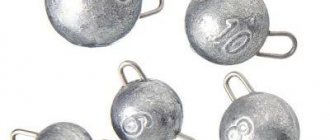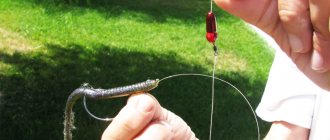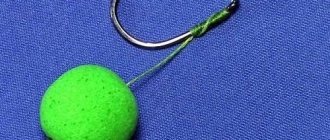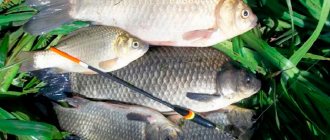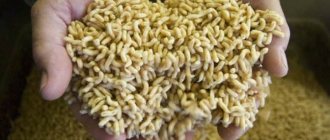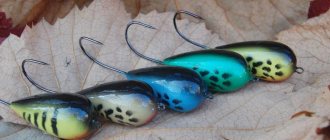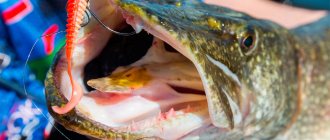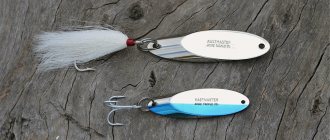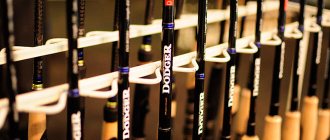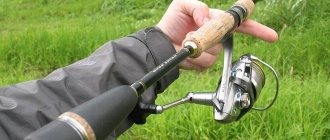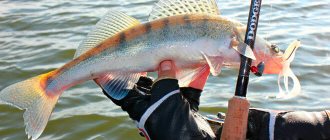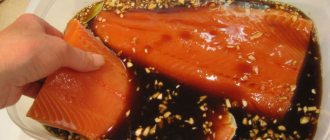This fishing method involves special spinning equipment, which is used to catch predatory fish in various water horizons, including those closer to the bottom.
As a rule, trophy specimens prefer to be at depth and stay at a considerable distance from the shore. Therefore, it is more effective to get a trophy pike or pike perch using jig equipment.
Jig baits are produced for jig equipment. They consist of two parts: the bait itself and the jig head, a certain weight and a certain shape. The weight of the jig head is selected depending on the fishing conditions. At great depths, heavy baits are used, and in shallows, lighter ones. The shape of the bait is selected according to the nature of the bottom of the reservoir. If the bottom is muddy, then it is preferable to opt for a jig head with a flat base.
The basis of any spinning fishing is the nature of the bait. It is obtained as a result of movements with the rod and winding of the line with the reel. At first glance, everything is very simple and accessible. In fact, everything is much more complicated and success comes as a result of long training.
Spinning for jig
The choice of jig rod is a very important factor influencing fishing performance. The characteristics of the rod must match the characteristics of the bait, otherwise it will not be possible to plausibly move the bait and hook the fish in time. The spinner must feel the bait and control it. It is very important to decide on the fishing conditions: either from the shore or from a boat. Only after determining the main factors that you will encounter while fishing should you start choosing a spinning rod.
If fishing is carried out from a boat, then a long spinning rod is absolutely not needed. On the contrary, with a shorter one, catching a predator from a boat is much more convenient. Therefore, a spinning rod with a length of 1.9 to 2.4 meters is suitable for such conditions.
For fishing from the shore, the following philosophy is suitable: the longer the spinning rod, the better, since you can’t do without long casts. But again, the larger the spinning rod, the heavier it is, and this is an additional load on the hands. Plus, there may be vegetation on the shore of the reservoir, which complicates the use of long rods. In this regard, you can focus on the following dimensions: 2.7-3.0 meters. As practice shows, such a form is absolutely sufficient for fishing from the shore.
All fishing rods are divided into certain categories, including by the nature of the rod's structure. For jig fishing, a fast or super-fast action may be most effective. This is necessary for fast and reliable hooking. In addition, fast action rods respond faster to bites. This is especially important when fishing for pike perch. It has a very powerful jaw, which needs to be broken through by hooking, and besides, the pike perch takes the bait very carefully.
Installation of jig baits (part 1)
As a rule, it should be a reliable rod with suitable test. The test indicates what weight of bait is best to use so that the wiring process is controlled. There are three main groups of rods, separated by test characteristics. The first group is ultralight rods, with a weight of up to 10 grams. As a rule, such rods are convenient for catching perch and other smaller fish. The second group, with dough from 10 to 30 grams, is intended for catching larger predators weighing up to 10 kg inclusive. Such spinning rods are most in demand, as they are more suitable for our fishing conditions.
The last group is rods with a weight of more than 30 grams, which are used for fishing at great depths and over long distances, where heavy jig heads are used. This subspecies is relevant if you have to fish on a river with a fast current.
The material of manufacture also plays an important role. If a fishing rod is made of modern materials, then it is not only durable, but also lightweight. The only drawback of such forms is their high cost, which is inaccessible to a wide range of spinning players.
Equipment
In addition to the classic equipment, there are several varieties of other rigs related to jigs.
Texas
The main difference of this equipment is the use of a special form of weight in the form of a bullet and an offset hook with a bait in the form of a worm. The bullet has a hole along its axis and slides along the main line.
At the bottom of the load there is a recess in the form of a sphere. This allows the top of the bait attached to the hook to be hidden in the weight. When bait is placed on an offset hook, the sting is hidden in the body of the bait.
Thus, the equipment almost completely eliminates snags.
The weight of the load should be small, otherwise the equipment will quickly fall to the bottom. Long lures in the shape of worms play better with a smooth fall and vertical movements.
Caroline
This rig is similar to the Texas rig, with the exception of some features. The bullet-shaped weight is located at a certain distance (from 40 cm to 1 meter) from the offset hook with bait.
This is one of the options for spaced equipment. The weight, dragging along the bottom, raises turbidity and creates noise, and the bait in the form of a worm, having a freer game, follows it.
Other accessories with offset hooks
The use of offset hooks is also possible with other baits, such as slugs, shad, which resemble a fish. These baits have a certain weight, so the use of additional weight is not necessary.
The use of these baits in a coastal zone with overgrown grass near the surface helps to catch grass pike and perch.
Front hook rig
In order to reduce snags, a hook option equipped with a plastic bridge that protects against snags can be used as equipment.
The bait is attached to a special spiral with a ring, which in turn is put on the hook and located on the bend. It turns out that the non-snacking hook is located in front of the bait.
The baits have the shape of slugs and worms and easily pass through the grass. The shank of the hook can be soldered with lead or lead plasticine, which resembles a lightweight jig head.
Equipment with a float or wobbler
These are rare types of jig rigs and few people know them. The equipment consists of a light classic jig and a wobbler or horizontal float. A wobbler or float is attached with a leash in front of the jig.
The equipment is used if it is necessary to fish a certain horizon in the water column. The float prevents the bait from completely sinking to the bottom.
Sometimes the fish attacks the float instead of the bait. Therefore, it is replaced with a wobbler, removing the rear tee.
Drifting bottom rig
When fishing on the current in shallow rivers, this type of equipment is used. At a distance of 40-60 cm from the hook with the bait, a leash made of fishing line (20-30 cm) is attached, onto which pellet weights are attached, like on a float tackle.
When caught on a rocky bottom, the pellets are pulled off, which preserves the remaining tackle without breaking.
"Petty tyrant"
The equipment consists of a weight tied to the end of the fishing line. Above the load, leashes with hooks and baits are tied at 20-30 cm intervals. There may be several of them. It all depends on the depth.
In most cases, this gear is used to fish vertically with a slight horizontal displacement. The equipment is used for sea fishing or deep-sea freshwater bodies.
Jig rig for pike
When fishing for pike, there is a high probability that the fishing line or braided cord will be cut off on the sharp teeth of the owner of the reservoir.
In order to prevent the loss of both the trophy specimen and all the equipment, a jig head or a weight with a hook is attached to a metal leash, and only then the leash is tied to the main fishing line.
The length of the metal leash or string must be at least 20 cm. If you intend to catch pike up to 10 kg or more, then a minimum leash of 40 cm must be used.
Trophy pike easily swallows a 15 cm bait and a 20 cm leash.
Jig reel
Jig fishing does not require any special equipment such as a reel. Basically, a regular spinning reel of the appropriate size is used. Nowadays, they are increasingly resorting to installing a multiplier reel, although this is not necessary. A multiplier (sea) reel is designed for catching large fish. It will be used, for example, for catching catfish. In all other cases, especially since it is more difficult to operate, it is quite possible to get by with an inertia-free coil that is easier to use.
As a rule, experienced spinningists choose high-quality spinning reels with a special spool coating. If a braided cord is used, a regular plastic spool will wear out quickly. The fact is that braid has abrasive properties. As for ordinary monofilament fishing line, there are no such requirements for the design of the reel.
Jig line
Most fishermen, especially in small rivers and lakes, use monofilament line, although braided line can also be used. Unfortunately, braided fishing line is more expensive than monofilament, but monofilament has a number of disadvantages, such as the presence of memory, increased specific stretch and lower strength compared to braided cord. Although there are fishing conditions when there is no alternative to monofilament fishing line. Some of its disadvantages can easily be turned into its advantages.
Therefore, the choice of fishing line is dictated by fishing conditions. At long distances, it is preferable to use braid, since you need to quickly transfer the bite to the tip of the rod, and at short distances, monofilament is sufficient, since in such conditions its stretchability does not affect the performance so much. In addition, its stretchability helps to absorb the jerks of large fish.
How to properly equip a JIG LURE. 6 ways to rig.
Jig lures
There are two main types of jig baits, depending on what material they are made of.
- Foam rubber baits . These are classic jig baits that are sold in retail outlets. Such baits are easy to make yourself, which is what many fishermen do. The result is inexpensive home-made baits designed for various fishing conditions.
- Silicone baits . Nowadays, such baits are very popular among jig fishing enthusiasts. In retail outlets you can find a huge variety of silicone baits, differing in shape and color. Thanks to the special properties of silicone, it was possible to create baits that imitate not only various fish, but also various animals, as well as insects and other representatives of the underwater world. Various flavors are added to the silicone, which increases the number of bites. This is the so-called edible rubber.
- Combined baits are created by the fishermen from the deteriorated parts of silicone baits. Silicone bonds very easily when exposed to heat. Therefore, by picking up a soldering iron, you can create your own masterpieces.
Jig head shapes
The performance of the bait directly depends on this parameter, not only when retrieving, but also during free diving. Experienced spinning anglers know that the more streamlined the shape of the head, the less water resistance the bait experiences and, of course, vice versa. The position in which the hook will meet the predator also depends on this characteristic.
The existing variety of head shapes is somewhat confusing to inexperienced fishermen. It can be difficult for them to understand all this choice of shapes, so many of them use only a simple ball-shaped sinker. Indeed, it can be called universal, since it is more capable than all others of “adjusting” to fishing conditions. But the more accurately a fisherman learns to select the shape of a sinker for a particular body of water, and the better he knows how to put on a jig head, the more effective his “silent hunt” will be. In addition, it will greatly reduce the number of snags and protect the gear from breaks.
Mounting the bait
There are several options for jig installation, depending on the nature of the load:
- Rigid jig head mount . This is the easiest way to mount a jig bait. In this case, the jig head is connected to the bait in such a way that the weight is in front of the bait, and the point of the hook comes out from above the bait.
- Flexible mount . This mounting option allows you to get a brighter game of the bait. The bait is put on the hook, and a weight, like a “Cheburashka”, is connected to the hook by means of a winding ring. The equipment can use both regular hooks with a long shank and offset ones. Offset hooks allow you to get a non-snagging bait.
In any case, the main thing is to choose the right hook size so that it matches the size of the bait. Quite often, double or triple hooks are used instead of single hooks. This increases fishing efficiency, but at the same time increases the risk of getting caught on underwater obstacles. You can learn how to properly attach bait to a regular or double hook on the Internet by watching the corresponding video. It is better to see once than to read several times, especially since it is not so easy to describe this process, and even more difficult to apply in practice.
Fishing. Mounting bait on a jig head
Jig-rig mounting options
You will see one of the simplest ways to mount a jig-rig using a regular fastener in this video. Everything is extremely simple. But there is one small nuance. First, you should wind the hook, followed by the sinker, so it will be more difficult for the clasp to unfasten and for you to drain the trophy.
A more complex version uses a winding ring. In such a setup, perhaps the bait will play more freely and a little more interesting. But the winding ring is an additional weak element in the equipment, and it is not always convenient to quickly put it on without a tool.
Sinker
Most often, lead weights are used in the form of a stick, an elongated drop or a “banana” . If they are catching small fish, say, perch, they use a more delicate installation - a drop of a less elongated shape or even a tungsten sinker, which is smaller in size compared to lead.
Hooks
The standard option is to use an offset hook. The jig-rig was intended as a non-snagging bait for fishing among the grass. But if your fishing areas are not so overgrown and snaggy, using a double is quite acceptable.
Loads
Cargoes vary not only in weight, but also in shape. Despite this, most jig heads are equipped with ball-shaped weights. They are suitable for almost all spinning fishing conditions. In addition to spherical weights, you can also find loads in the shape of a “boot” or “iron”. As a rule, such loads are characterized by the presence of a wide bottom plane, which does not allow it to fall into the silt.
Making your own jig head
Making a jig head with your own hands is quite simple. If the choice is made of lead, then metal is simply poured into the casting mold from above. Volumetric jig heads are made from two halves. In this case, the alloy is poured through special holes, and special vents are made to remove air from the workpieces. The sinker mold can be made from aluminum or steel, as well as from heat-resistant silicone, gypsum and other polymers.
To do this, you will need a ready-made jig head, a copy of which must be made. First, take a cardboard box, mix the gypsum solution and fill it halfway. In this case, you need to ensure that the substance lies tightly and without air. Then the solution will begin to thicken. When it becomes a little hard, the finished product, lubricated with oil, is pressed into it. After this, holes for filling are made using a drill. When the mold is completely dry, it can be used.
Jig wiring
The effectiveness of jig fishing depends on a whole set of factors that one way or another affect the performance. The skill of the spinning player is of no small importance. The ability to correctly present the bait and move it plausibly so that the predator sees its prey in it and decides to attack is one of the main conditions for the effectiveness of the gear.
Classic wiring is a regular step, which is formed either by moving the rod upward or by cyclically winding the fishing line. If a step is formed by the movement of the rod, then after it you need to immediately remove the slack in the fishing line, otherwise you will not be able to detect the bite in time. If you make not one swing of the rod, but several, but shorter ones, you will get a large step, which will include several small steps. Such variety attracts fish more and the result does not take long to wait.
Sometimes even wiring is required, which may be due to the nature of the bait used. If it is a vibrating tail, then moderate, uniform wiring quite plausibly imitates the movement of a fish. Depending on the behavior of the fish, sometimes a slow and sometimes a fast aggressive retrieve is required, which provokes the predator to attack.
Wiring for demolition is used on rivers. In this case, the bait is thrown upstream somewhere at an angle of 45 degrees. The bait begins to sink to the bottom and the current carries it away. Small twitches of the rod make the bait seem to bounce on the bottom, which attracts both pike and zander.
What types of jig wiring exist?
To be demolished
Wiring for demolition (for demolition) is used when fishing in the current. The bait is cast at an angle of about 45 degrees upstream and after it touches the bottom, it is animated with the tip of the spinning rod, making short jerks without unwinding the line. The bait seems to be jumping downstream on its own, and only when the cord is stretched like a stream, do they begin to drag the bait, performing one or another wiring.
Russian
Russian or classic step retrieving involves making two turns with the reel handle after the bait touches the bottom. After reeling in the cord, the bait falls, during which a bite most often occurs, although it can also happen at the moment the bait comes off the bottom and during its upward movement.
Expert opinion
Knipovich Nikolai Mikhailovich
Zoologist, hydrobiologist. I am interested in fishing at a professional level.
Attention! The moment the bait touches the bottom can be tracked in three ways: tactilely, by the tip of the spinning rod and by the sag of the cord. Sensitivity “in the hand” is considered optimal, but it can only be achieved when using high-quality gear and not under all conditions.
American
During the American retrieve, the bait moves in the same way as during the Russian retrieve, however, the detachment of the bait from the bottom occurs not due to the rotation of the reel spool, but due to the jerk performed by the tip of the spinning rod. Compared to Russian wiring, American wiring is more aggressive.
Pendulum
This type of wiring is used in places rich in hooks. The bait is placed on the bottom, and then a smooth jerk is made with an amplitude of 15-20 centimeters, after which the tip of the rod is immediately pulled back 10 centimeters, after which the slack is pulled out.
Short
Short wiring resembles Russian wiring, but only one turn is made with the reel handle, and the duration of the pause is reduced to a minimum. Short wiring is used for catching passive fish.
Dotted
The essence of dotted wiring is to perform a series of short jerks with the tip of the spinning rod with virtually no pauses. The cord is constantly unwinding. This method is effective when catching pike perch.
Uniform
Uniform retrieving is achieved by rotating the reel handle at the same pace. It is better to use silicone bait as bait, which has its own game.
Jig heads
The jig head structurally consists of a hook of the appropriate size, cast into a load of the appropriate shape and weight. As a rule, special hooks with a long shank are used to produce jig heads. The hook is positioned so that its tip always faces upward. Here on the load there is an eyelet for fastening, which is also directed upward. The result is a structure with a mixed center of gravity, which pulls the bait down. This factor makes it easy to control the movement of the bait. The shape of the load can be any, as this does not affect its catchability.
9 ways to install silicone baits part 1
How to tie a jig head?
Fishermen ask themselves a variety of questions. And one of the main ones is about how to attach a jig head. Today there are a huge number of plastic soft baits on sale and a very small selection of jig heads corresponding to them. There are only two types of sinkers: those with lead “noses” on the shank of the hook and those that do not have such a beard. The latter have only a small “holder” for the bait, which is a wire spring, which, when screwed in, secures the bait.
But many, not knowing how to attach a jig head, tear the silicone. But in fact, everything is very simple: the finished bait should not have any tightness between the load and the sting. To do this, you first need to mark the place from which the hook should come out. By attaching a jig head to the bait, a puncture is made with a needle or awl. Then the bait is pierced with a sting from the head, strung on the fore-end and brought out in the intended place.
The first thing you need to know about how to rig a jig head is hook length. To do this, you need to attach the sinker to the bait, and in such a way that it fits tightly to the beginning of the vibrotail or twister. The hook itself should come out where the “tummy” of the first one ends or at the very tail of the last one. The hook is inserted into the body of the jig bait smoothly, while carefully inserting the silicone. At the same time, it can be positioned at a slight angle. When putting on a silicone nozzle, you need to try to pierce it all the way so that the notch goes inside the twister or vibrating tail. This is done to reduce the likelihood of the bait being pulled back.
Types of equipment
There are several types of spinning equipment.
Texas
The rig called Texas is characterized by the presence of a weight in the form of a bullet and an offset hook, on which there is a bait in the form of a worm. The weight has a hole running along its axis, as a result of which it can slide along the fishing line. At the bottom of the load there is a recess in the form of a hemisphere in which the upper part of the bait can be hidden. When using an offset hook, its tip can be hidden in the body of the bait, which reduces snags to a minimum.
At the same time, it is necessary to select the correct weight of the load so that it slowly sinks to the bottom. Lures such as worms are especially effective when slowly lowered or moved vertically.
Caroline
This equipment is similar to the previous one, with minor features. This installation is based on the principle of spaced equipment, since the load is located at a distance of 40 cm to 1 m from the bait. In this case, the load can drag along the bottom creating turbidity and attracting fish, and the bait in the form of a worm is in a free state, which leads to its characteristic game.
Other accessories with offset hooks
In the case of using offset hooks, it is possible to use not only worms as bait, but also other types of bait, such as slugs or shads, imitating the movement of a fish. Since the baits have a certain weight, it is not necessary to load them. Such baits catch pike and perch well.
Front hook rig
To minimize the likelihood of snagging, the hooks are equipped with plastic bridges. For this purpose, special spirals with rings are used, which are placed on the hook in the area of its bend. It turns out that the bait is located behind the non-snaking hook. Baits such as worms and slugs are designed to pass through grass easily due to their shape. The hook must be loaded by soldering its shank with lead solder or lead plasticine. As a result, the design will resemble a jig head.
Equipment with a float or wobbler
Such equipment is rare, since it is little known and rarely used by anyone. It is based on a light jig rig, to which a wobbler or horizontal float is added. This is necessary when a fixed immersion depth is required, which provides a horizontal float. Very often the fish attacks the float. In this case, the float can be replaced with a floating wobbler by removing the rear tee.
Drifting bottom rig
A similar installation is used when fishing in the current. Below the hook with the bait, at a distance of 40-60 cm, a leash with a set of weights, such as a pellet, is attached. In case of snags, the pellets move, freeing themselves from the snags. As a result, the equipment always remains intact.
Petty tyrant
Such equipment consists of a weight attached to the end of the main fishing line. At a distance of 20-30 cm from it there are several leashes with hooks on which baits are placed. With the help of such equipment they catch fish in a vertical line. As a rule, it is used for fishing at sea, where there is significant depth.
Jig rig for pike
As you know, pike have very sharp teeth and can easily bite through ordinary fishing line. In this regard, it makes no sense to attach the bait directly to the fishing line. To prevent the pike from biting off the bait, a metal leash is installed between it and the fishing line. Its length depends on the size of the predator that can peck. As a rule, a 20-centimeter leash is sufficient. When catching large specimens, it is possible to install a 40 cm leash.
Fishing using various jig equipment.
Jig rigs
Articulated
The articulated rig is a classic jigging rig because it uses all three elements: weight, hook and bait. The articulated rig has good aerodynamics compared to a jig head. During wiring, thanks to the movable joint, not only the active element of the bait works, but also the bait itself.
Hinged equipment offers several equipment options. The most famous are offset hook rigs and double hook rigs. The first option can be used in places with snags. The percentage of bites on a bait with a hook tip recessed in its body is lower than when fishing on an open hook, but with the right equipment you can reduce the number of idle bites to a minimum, as well as the consumption of bait. Many vibrotails currently have a special groove on their back into which the offset sting is hidden.
Expert opinion
Knipovich Nikolai Mikhailovich
Zoologist, hydrobiologist. I am interested in fishing at a professional level.
Important! The weight of the load depends on the thickness of the cord used and the fishing conditions. The main conditions that influence jig fishing are depth, current speed, and wind speed and direction.
Texas
The Texas rig consists of a weight made in the form of a bullet with a recess in the back, into which the offset hook eye is hidden. The silicone bait, of course, is mounted in the non-hooking version. Texas equipment has exceptional maneuverability through any obstacles. It can be carried out with any uneven wiring, including stepwise, but its special purpose is for fishing in snags. They use special wiring where the bait can be played in one place if you throw it over a snag.
Caroline
The Carolina rig is a spaced rig, and although it can be used in combination with some kind of jig, its main area of application is fishing in places with various obstacles. The Carolina rig consists of a sinker, the shape of which ensures good passage through obstacles, and a leash with a hook and a bait attached to it, which crawls behind the sinker. Carolina rig is used for catching passive fish.
Drifting bottom
This type of equipment is used for fishing in the current. The equipment consists of a shorter leash with a chain of weights and a longer one with bait. When fishing along the bottom, only a chain of weights crawls, and the bait itself moves at a certain distance from the bottom.
With front hook
This equipment consists of an offset hook with a spring attached to its bend, onto which the front part of the silicone bait is screwed. The bait can be carried evenly or in light jerks through shallow water. In order to fish at greater depths, a lead sausage is soldered onto the shank of the hook or ready-made hooks with a similar weight are used.
With float
This equipment is used when you want to ensure that the bait moves at a certain distance from the surface of the water. To do this, the bait is tied on a leash to a horizontally lying float or wobbler without a rear tee.
Petty tyrant
This equipment can be called a jigging conditionally, since the only thing it has in common with a jig is that you have to catch it by jerking. Samodur is a fishing line with a weight at the end and several leashes with hooks attached to it, on which baits may or may not be attached (photo 1). The tyrant is usually used to catch sea fish in a vertical line, but sometimes you can also catch perch with it.
Jig fishing technique
The jig fishing technique is quite simple and effective. It allows you to fish both shallows and deep-water areas of reservoirs. After casting the bait, you need to wait for the bait to reach the bottom. Experienced spinning anglers can easily determine this by the sagging of the fishing line. After this, you can begin wiring. As practice shows, you have to use several wiring techniques to interest a predator. If there are no bites, then proceed to replacing the bait with another, more attractive one, or switch to another type of bait altogether.
When fishing from the shore, you have to make long casts, 70-100 meters, and you can’t do it without a high-quality fishing rod. But this is not the most important thing. The most important thing is to determine a promising place where pike or other fish can stand. You need to look for holes, as well as exits from them. Including the edges, after which you should actively fish them.
Igor 05/05/2017
Tactics and techniques of fishing with jig rigs
In still water
On any fishing trip, the main element of tactics is finding fish. For classic jig fishing, the topography of the bottom of the reservoir is of great importance. Its features are determined using an echo sounder when fishing from a boat, and when fishing on the shore by indirect signs or by “punching” the bottom using a jig bait.
The fishing technique consists in selecting the bait that is most attractive to the fish, and the wiring method with which this bait should be animated.
On the current
When fishing in the current, it is important to clearly determine the direction of casting. Fishing technique is the selection of the optimal weight of the load and the desired fishing method.
